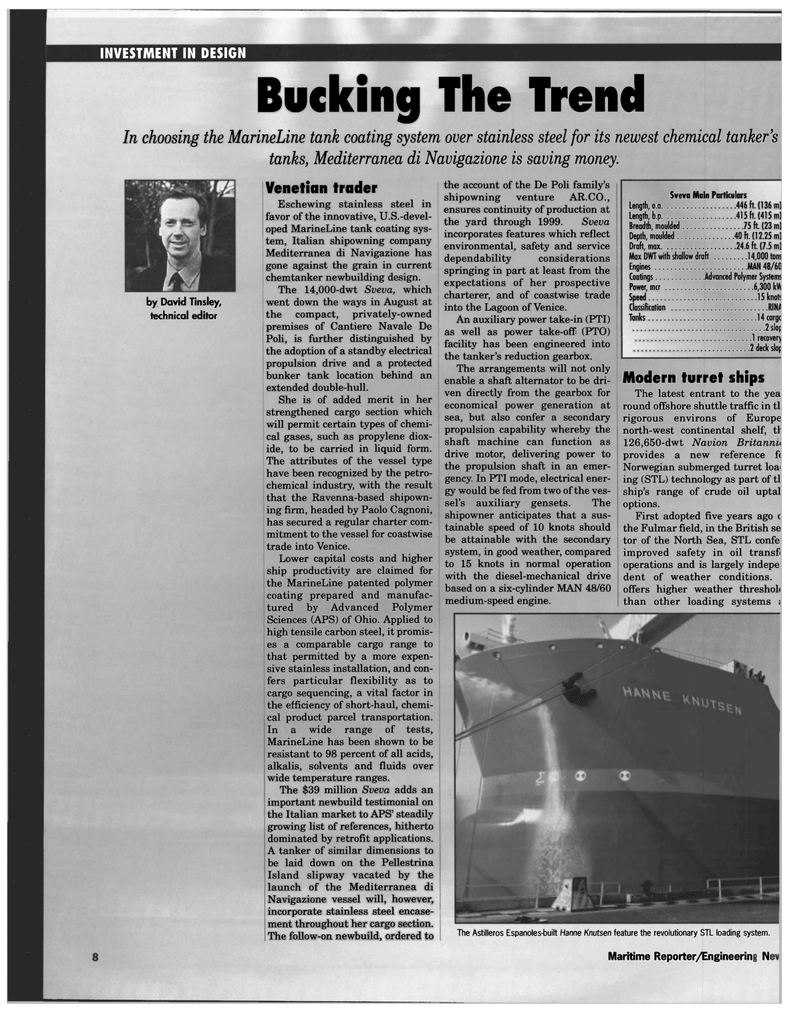
Page 8: of Maritime Reporter Magazine (September 1998)
Read this page in Pdf, Flash or Html5 edition of September 1998 Maritime Reporter Magazine
INVESTMENT IN DESIGN
Bucking The Trend
In choosing the MarineLine tank coating system over stainless steel for its newest chemical tanker's tanks, Mediterranea di Navigazione is saving money. by David Tinsley, technical editor
Venetian trader
Eschewing stainless steel in favor of the innovative, U.S.-devel- oped MarineLine tank coating sys- tem, Italian shipowning company
Mediterranea di Navigazione has gone against the grain in current chemtanker newbuilding design.
The 14,000-dwt Sveva, which went down the ways in August at the compact, privately-owned premises of Cantiere Navale De
Poli, is further distinguished by the adoption of a standby electrical propulsion drive and a protected bunker tank location behind an extended double-hull.
She is of added merit in her strengthened cargo section which will permit certain types of chemi- cal gases, such as propylene diox- ide, to be carried in liquid form.
The attributes of the vessel type have been recognized by the petro- chemical industry, with the result that the Ravenna-based shipown- ing firm, headed by Paolo Cagnoni, has secured a regular charter com- mitment to the vessel for coastwise trade into Venice.
Lower capital costs and higher ship productivity are claimed for the MarineLine patented polymer coating prepared and manufac- tured by Advanced Polymer
Sciences (APS) of Ohio. Applied to high tensile carbon steel, it promis- es a comparable cargo range to that permitted by a more expen- sive stainless installation, and con- fers particular flexibility as to cargo sequencing, a vital factor in the efficiency of short-haul, chemi- cal product parcel transportation.
In a wide range of tests,
MarineLine has been shown to be resistant to 98 percent of all acids, alkalis, solvents and fluids over wide temperature ranges.
The $39 million Sveva adds an important newbuild testimonial on the Italian market to APS' steadily growing list of references, hitherto dominated by retrofit applications.
A tanker of similar dimensions to be laid down on the Pellestrina
Island slipway vacated by the launch of the Mediterranea di
Navigazione vessel will, however, incorporate stainless steel encase- ment throughout her cargo section.
The follow-on newbuild, ordered to the account of the De Poli family's shipowning venture AR.CO., ensures continuity of production at the yard through 1999. Sveva incorporates features which reflect environmental, safety and service dependability considerations springing in part at least from the expectations of her prospective charterer, and of coastwise trade into the Lagoon of Venice.
An auxiliary power take-in (PTI) as well as power take-off (PTO) facility has been engineered into the tanker's reduction gearbox.
The arrangements will not only enable a shaft alternator to be dri- ven directly from the gearbox for economical power generation at sea, but also confer a secondary propulsion capability whereby the shaft machine can function as drive motor, delivering power to the propulsion shaft in an emer- gency. In PTI mode, electrical ener- gy would be fed from two of the ves- sel's auxiliary gensets. The shipowner anticipates that a sus- tainable speed of 10 knots should be attainable with the secondary system, in good weather, compared to 15 knots in normal operation with the diesel-mechanical drive based on a six-cylinder MAN 48/60 medium-speed engine.
Sveva Main Particulars
Length, o.a 446 ft. (136 m)
Length, b.p 415 ft. (415 m)
Breadth, moulded 75 ft. (23 m)
Depth, moulded 40 ft. (12.25 m]
Draft, max 24.6 ft. (7.5 m]
Max DWT with shallow draft 14,000 tons
Engines MAN 48/60
Coatings Advanced Polymer Systems
Power, mcr 6,300 kW
Speed 15 knot;
Classification RIW
Tanks 14 cargc 2 slop 1 recovery 2 deck slof
Modern turret ships
The latest entrant to the yea round offshore shuttle traffic in tl rigorous environs of Europe north-west continental shelf, tt 126,650-dwt Navion Britannu provides a new reference f<
Norwegian submerged turret loai ing (STL) technology as part of tl ship's range of crude oil uptal options.
First adopted five years ago c the Fulmar field, in the British se tor of the North Sea, STL confe improved safety in oil transf operations and is largely indepe dent of weather conditions, offers higher weather threshold than other loading systems ;
The Astilleros Espanoles-built Hanne Knutsen feature the revolutionary STL loading system. 10 Maritime Reporter/Engineerine No»-

 7
7

 9
9
